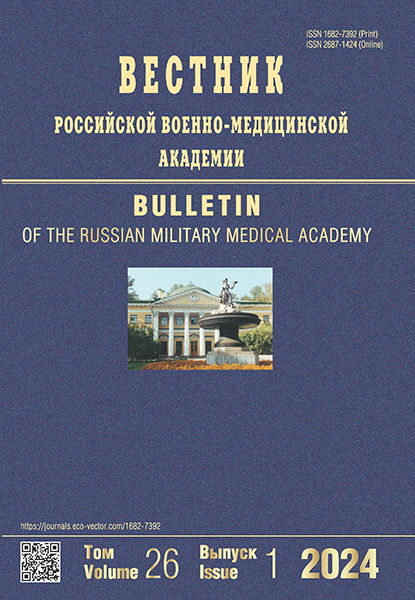新型冠状病毒肺炎患者端粒长度和端粒酶活性的检测结果
- 作者: Makiev R.G.1, Mironov I.V.1
-
隶属关系:
- Kirov Military Medical Academy
- 期: 卷 26, 编号 1 (2024)
- 页面: 15-22
- 栏目: Original Study Article
- ##submission.dateSubmitted##: 18.10.2023
- ##submission.dateAccepted##: 14.01.2024
- ##submission.datePublished##: 02.04.2024
- URL: https://journals.eco-vector.com/1682-7392/article/view/611009
- DOI: https://doi.org/10.17816/brmma611009
- ID: 611009
如何引用文章
详细
评估了端粒长度和端粒酶活性对重症冠状病毒肺炎中的预后价值。我们对 53 例新型冠状病毒肺炎患者进行了前瞻性观察研究,并根据临床病程的严重程度将其分为两组:第一组—非重症病程(16 例患者),第二组—重症病程(37 例患者)。采集所有患者的静脉血并进行分子基因检测,以确定端粒长度和淋巴细胞端粒酶活性。测定新型冠状病毒肺炎患者的端粒长度和端粒酶活性对预后具有重要价值。研究发现,与非重症新型冠状病毒肺炎患者相比,重症新型冠状病毒肺炎患者入院和出院时的端粒长度值较低。因此,第一组患者入院时的端粒长度为6343个核苷酸对,而第二组患者的端粒长度明显较低(p < 0.001),为5264个核苷酸对。出院时,两组患者的端粒长度与基线水平相比均有显著下降(p < 0.001),第一组患者为5654个核苷酸对,第二组患者为3274个核苷酸对。根据端粒酶活性水平对各组患者人数进行比较后发现,肺炎病程的严重程度与端粒酶活性之间存在正相关关系。因此,第一组中有2例(12.5%)患者在入院治疗时端粒酶活性较高,而第二组中有9例(24.3% )患者的端粒酶活性较低。第一组有3例(18.8%)患者的端粒酶活性处于平均水平,而第二组有15例(40.6%)患者的端粒酶活性处于平均水平。第一组有11例患者(68.7%)和第二组有13例患者(35.1%)端粒酶活性较低,但这一指标在组内没有明显差异。出院时,第一组患者中没有酶活性水平高的患者,第二组患者中有4例(10.8%)。第一组有3例(18.8%)患者的端粒酶活性达到了平均水平,第二组有15例(40.6%)患者的端粒酶活性达到了平均水平。第 一 组中有13例(81.2%)患者端粒酶活性水平较低,而第二组中端粒酶活性水平较低(p = 0.028)的患者明显较多,有18例(48.7%)。所有这些都表明了使用这些指标作为冠状病毒肺炎预后和结果因素的前景。
全文:
作者简介
Ruslan G. Makiev
Kirov Military Medical Academy
Email: vmeda-nio@mil.ru
ORCID iD: 0000-0002-2180-6885
SPIN 代码: 4703-5573
MD, Dr. Sci. (Med.), associate professor
俄罗斯联邦, Saint PetersburgIlya V. Mironov
Kirov Military Medical Academy
编辑信件的主要联系方式.
Email: vmeda-nio@mil.ru
ORCID iD: 0000-0001-8382-8951
SPIN 代码: 9427-5456
assistant to the head of the scientific department
俄罗斯联邦, Saint Petersburg参考
- Schultze JL, Aschenbrenner AC. COVID-19 and the human innate immune system. Cell. 2021;184(7):1671–1692. doi: 10.1016/j.cell.2021.02.029
- Arunachalam PS, Wimmers F, Mok CKP, et al. Systems biological assessment of immunity to mild versus severe COVID-19 infection in humans. Science. 2020;369(6508):1210. doi: 10.1126/science.abc6261
- Kryukov EV, Trishkin DV, Ivanov AM, et al. Comparative cohort epidemiological study of collective immunity against new coronavirus infection among different groups of military personnel. Annals of the Russian Academy of Medical Sciences. 2021;76(6):661–668. EDN: KBCNYC doi: 10.15690/vramn1583
- Sahin E, Colla S, Liesa M, et al. Telomere dysfunction induces metabolic and mitochondrial compromise. Nature. 2011;470(7334):359–365. doi: 10.1038/nature09787
- Xu W, Wong G, Hwang YY, Larbi A. The untwining of immunosenescence and aging. Semin Immunopathol. 2020;42(5):559–572. doi: 10.1007/s00281-020-00824-x
- Charles PGP, Wolfe R, Whitby M, et al. SMART-COP: a tool for predicting the need for intensive respiratory or vasopressor support in community-acquired pneumonia. Clin Infect Dis. 2008;47(3): 375–384. doi: 10.1086/589754
- Protasova MS, Reshetov DA. Methodological manual for the workshop “New genomic approaches for identification of genetic factors of aging”. Moscow: Tsifrovichok, 2013. 42 p. (In Russ.)..
- O’Callaghan NJ, Dhillon VS, Thomas P, Fenech M. A quantitative real-time PCR method for absolute telomere length. Biotechniques. 2008;44(6):807–809. doi: 10.2144/000112761
- Boulay J-L, Reuter J, Ritschard R, et al. Gene dosage by quantitative real-time PCR. Biotechniques. 1999;27(2):228–230. doi: 10.2144/99272bm03
- Sanchez-Vazquez R, Guío-Carrión A, Zapatero-Gaviria A, et al. Shorter telomere lengths in patients with severe COVID-19 disease. Aging-Us. 2021;13(1):1–15. doi: 10.18632/aging.202463
- Cohen S, Janicki-Deverts D, Turner RB, et al. Association between telomere length and experimentally induced upper respiratory viral infection in healthy adults. JAMA. 2013;309(7):699–705. doi: 10.1001/jama.2013.613
- Najarro K, Nguyen H, Chen G, et al. Telomere length as an indicator of the robustness of B- and T-cell response to influenza in older adults. J Infect Dis. 2015;212(8):1261–1269. doi: 10.1093/infdis/jiv202
- Weng N-P. Telomeres and immune competency. Curr Opin Immunol. 2012;24(4):470–475. doi: 10.1016/j.coi.2012.05.001
- Smith ALM, Whitehall JC, Bradshaw C, et al. Age-associated mitochondrial DNA mutations cause metabolic remodelling that contributes to accelerated intestinal tumorigenesis. Nat Cancer. 2020;1(10):976–989. doi: 10.1038/s43018-020-00112-5
- Tumburu L, Ghosh-Choudhary S, Seifuddin FT, et al. Circulating mitochondrial DNA is a proinflammatory DAMP in sickle cell disease. Blood. 2021;137(22):3116–3126. doi: 10.1182/blood.2020009063
- Fitzpatrick AL, Kronmal RA, Kimura M, et al. Leukocyte telomere length and mortality in the cardiovascular health study. J Gerontol A Biol Sci Med Sci. 2011;66(4):421–429. doi: 10.1093/gerona/glq224
- Njajou OT, Hsueh W-C, Blackburn EH, et al. Association between telomere length, specific causes of death, and years of healthy life in health, aging, and body composition, a population-based cohort study. J Gerontol A Biol Sci Med Sci. 2009;64(8):860–864. doi: 10.1093/gerona/glp061
- Verhulst S, Susser E, Factor-Litvak PR, et al. Commentary: The reliability of telomere length measurements. Int J Epidemiol. 2015;44(5):1683–1686. doi: 10.1093/ije/dyv166
- Spivak IM, Mironov IV, Zhekalov AN, Glushakov RI. Telomere length as a possible predictor of the severity of COVID-19 pneumonia. Russian Military Medical Academy Reports. 2020;39(S3-1):205–209. (In Russ.). EDN: VEASXW
- Spivak IM, Zhekalov AN, Mironov IV, et al. Telomere length shortening in pneumonia caused by novel coronavirus infection. Health is the basis of human potential: problems and ways of their solution. 2021;16(1):371–377. (In Russ.).
补充文件






